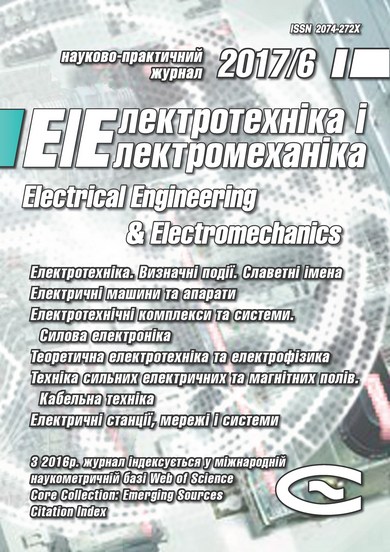INFLUENCE OF ARMATURE PARAMETERS OF A LINEAR PULSE ELECTROMECHANICAL CONVERTER ON ITS EFFICIENCY
DOI:
https://doi.org/10.20998/2074-272X.2017.6.03Keywords:
linear pulse electromechanical converter, mathematical model, electrically conductive, coil and ferromagnetic armature, integral efficiency index, efficiency evaluation strategyAbstract
Purpose. The evaluation of the effect of armature parameters on the efficiency of a linear pulsed electromechanical converter, taking into account the power, speed, constructive and environmental parameters. Methodology. First, the height of the electrically conductive, coil and ferromagnetic armature of a linear pulse electromechanical converter is determined, at which the highest velocity develops. An integral efficiency index is introduced, which takes into account, in a relative way, the power, speed, energy, electrical and field characteristics of the converter. Variants of the efficiency evaluation strategy are used that take into account the priority of each indicator of a linear pulse electromechanical converter using the appropriate weighting factor in the integral efficiency index. Results. A mathematical model of a linear pulsed electromechanical converter is developed. It is established that as the height of the electroconductive, coil and ferromagnetic armature increases, the force pulse increases. The greatest speed develops with the use of a coil armature, and the smallest with an electroconductive armature. In the converter with coil and ferromagnetic armature, practically the same values of the electrodynamic and electromagnetic force pulse are realized, while in the converter the electrodynamic force is 1.52 times smaller in the converter by the electrically conductive armature. It is established that with all efficiency evaluation strategies, the converter with a coil armature is the most effective, even in spite of its constructive complexity, and the converter with a ferromagnetic armature is the least effective, although it is constructively the simplest. Originality. For the first time, using the integral efficiency index, which takes into account the power, speed, energy, electrical and field indices in a relative way, it is established that with all efficiency evaluation strategies, the converter with a coil armature is the most effective, and the converter with a ferromagnetic anchor is the least effective. Practical value. The height of the electrically conductive, coil and ferromagnetic armature of a linear pulse electromechanical converter is determined, at which the highest speed develops. It is shown that when using an electrically conductive armature, the value of the electrodynamic force pulse is lower than when using a coil and ferromagnetic armature. It is established that the converter with a coil armature is the most efficient, and the converter with a ferromagnetic armature is the least effective.References
1. Balikci A., Zabar Z., Birenbaum L., Czarkowski D. Improved performance of linear induction launchers. IEEE Transactions on Magnetics, 2005, vol.41, no.1, pp. 171-175. doi: 10.1109/tmag.2004.839283.
2. Bissal A., Magnusson J., Engdahl G. Comparison of two ultra-fast actuator concept. IEEE Transactions on Magnetics, 2012, vol.48, no.11, pp. 3315-3318. doi: 10.1109/tmag.2012.2198447.
3. Bolyukh V.F., Luchuk V.F., Rassokha M.A., Shchukin I.S. High-efficiency impact electromechanical converter. Russian electrical engineering, 2011, vol.82, no.2, pp. 104-110. doi: 10.3103/s1068371211020027.
4. Young-woo Jeong, Seok-won Lee, Young-geun Kim, Hyun-wook Lee. High-speed AC circuit breaker and high-speed OCD. 22nd International Conference and Exhibition on Electricity Distribution (CIRED 2013), 2013, 10-13 June, Stockholm, Paper 608. doi: 10.1049/cp.2013.0834.
5. Bolyukh V.F., Shchukin I.S. Lineinye induktsionno-dinamicheskie preobrazovateli [Linear induction-dynamic converters]. Saarbrucken, Germany, LAP Lambert Academic Publ., 2014. 496 p. (Rus).
6. Bolyukh V.F., Oleksenko S.V. The influence of the parameters of a ferromagnetic shield on the efficiency of a linear induction-dynamic converter. Russian Electrical Engineering, 2015, vol.86, no.7, pp. 425-431. doi: 10.3103/s1068371215070044.
7. ВolyukhV.F., Oleksenko S.V., Shchukin I.S. Comparative analysis of linear pulse electromechanical converters electromagnetic and induction types. Technical Electrodynamics, 2016, no.5, pp. 46-48. (Rus).
8. D.-K. Lim, D.-K. Woo, I.-W. Kim, D.-K. Shin, J.-S. Ro, T.-K. Chung, H.-K. Jung. Characteristic Analysis and Design of a Thomson Coil Actuator Using an Analytic Method and a Numerical Method. IEEE Transactions on Magnetics, 2013, vol.49, no.12, pp. 5749-5755. doi: 10.1109/tmag.2013.2272561.
9. Comsol Multiphysics modeling and simulation software. Available at: http://www.comsol.com (accessed 05 May 2015).
10. Bolyukh V.F., Oleksenko S.V., Shchukin I.S. Efficiency of linear pulse electromechanical converters designed to create impact loads and high speeds. Electrical engineering & electromechanics, 2015, no.3, pp. 31-40. (Rus). doi: 10.20998/2074-272X.2015.3.05.
11. ВolyukhV.F., Kocherga A.I., Shchukin I.S. Multicriterial selection of parameters of the external screen of a linear pulse electromechanical transducer. Electrotechnic and computer systems, 2017, no.25(101), pp. 106-116. (Rus).
Downloads
Published
How to Cite
Issue
Section
License
Copyright (c) 2017 V. F. Bolyukh, A. I. Kocherga, I. S. Schukin

This work is licensed under a Creative Commons Attribution-NonCommercial 4.0 International License.
Authors who publish with this journal agree to the following terms:
1. Authors retain copyright and grant the journal right of first publication with the work simultaneously licensed under a Creative Commons Attribution License that allows others to share the work with an acknowledgement of the work's authorship and initial publication in this journal.
2. Authors are able to enter into separate, additional contractual arrangements for the non-exclusive distribution of the journal's published version of the work (e.g., post it to an institutional repository or publish it in a book), with an acknowledgement of its initial publication in this journal.
3. Authors are permitted and encouraged to post their work online (e.g., in institutional repositories or on their website) prior to and during the submission process, as it can lead to productive exchanges, as well as earlier and greater citation of published work.




